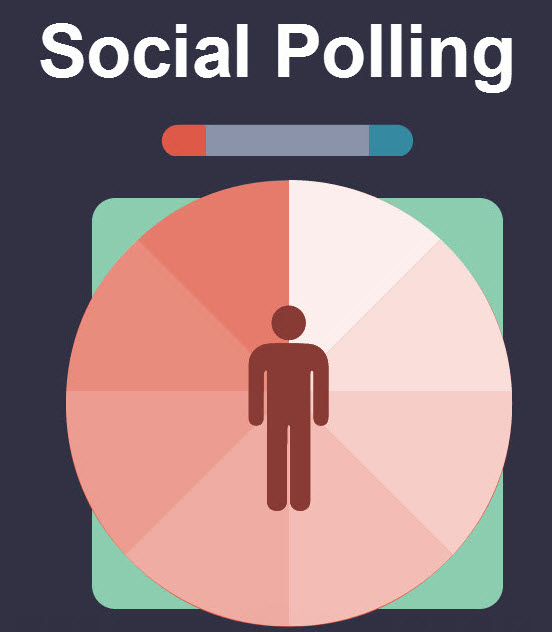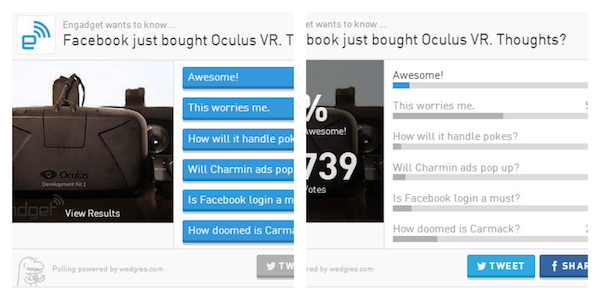Polling is one of the most powerful tools brands can incorporate into a social strategy. Below are a few reasons why you should consider incorporating polling into your next marketing campaign. The five key points are followed by a few recommendations for tools to use for polling.

1. Free Product Feedback
Brands often pay a lot of money to have outside services and companies survey customers to get product feedback. Others use social listening tools to see what people are saying about their products.
Why not be more direct and just ask the customers on a social media channel?
If a person has followed your brand on a social network, there’s a good chance that they think very highly of your brand. These are the people that are going to provide some of the most honest and lengthy feedback, and they will gladly do it for free.
Polling on social channels will improve your product and site by helping you identify shortcomings to fix.

2. Gain Deep Understanding of Customers and Community in Real-Time
Soliciting opinions in real-time can help you better understand the community and the types of things they enjoy.
Polling provides deep insight into your readers and customers, and it can improve the development of marketing and advertising campaigns.
Are your customers fans of the World Cup? Then maybe we should run a campaign that has a soccer theme.
Do your customers like Apple more than Samsung? Then maybe we should develop our app on iOS before Android.
3. Community Building
Porter Haney, CEO of social polling company Wedgies, says that polls are a “unique way” to spark conversation and engagement. Polling shows your customers that the communication channel isn’t a one-way street, and it invites them to join the fun.
Seeking input from the community also tells them that you are listening and that you want to make your products and websites better.
Broadcasting the results demonstrates that you want the world to know what your community thinks about a certain topic. Also, if the product feedback is used to build a better site/product, customers will be happy.
Doesn’t everyone want happy customers to tell friends about their amazing community and product?
4. Content Generation
Another beauty of social media polling is that it creates two pieces of content. The first is the actual poll itself, and the second is when you showcase the results. Imagine if every article you wrote multiplied into two articles. That’s what polls can do.

5. Traffic Lift
By having two pieces of content from one poll and encouraging users to share the poll, you might also experience an increase in traffic to your blog.
Porter Haney says that social polling is a “really good way for marketers to drive extra traffic.” He mentions that “the flow (on average) is something like this: 20 percent of readers vote on the poll, 15 percent of those voters share the poll, resulting in a 2-3 percent share rate of the page.”
Each of the social shares incrementally increases the traffic to the page, so you could end up with a 20 percent boost in traffic to a page with a poll.
Polling Tools
Polling is a great way to get product feedback, gain a deep understanding of customers and community in real-time, build a community, generate content, and boost traffic. Before you start implementing polling, what tools should you use?
The easiest way to do social polling is simply posting an open or closed-ended question to Facebook or Twitter. This is free to do, but it can sometimes be hard to curate a large set of responses and have users share the results.
Fortunately a number of great tools can take your social polling to the next level. I recommend looking at:
- POLL: The POLL app works well within Facebook, and it’s great for sharing results. It’s free to use, but the non-ad version will cost a small fee.
- Wedgies: Wedgies is a beautiful and interactive polling tool that can be embedded into a blog or Tumblr post. The poll and the results “cards” make for a fun and shareable piece of content. Wedgies works best for close-ended questions, but it also helps spark discussion within the comments section of a blog posts. It’s relatively inexpensive, and it can be seen in action on sites like Engadget or Joystiq (full disclosure: I work for AOL, which owns Engadget and Joystiq).
- Poptip: Another great polling tool that’s being used by E! Online and the NHL is Poptip. If you want to use open-ended questions, Poptip does a great job organizing the unstructured conversation into more formal categories. Similar to Wedgies, Poptip also has a shareable “results card.”
Have You Tried Social Media Polling?
Are there other social media polling tools that you’ve found useful? Tell us about your “best practices” and favorite polling tools in the comments section.


